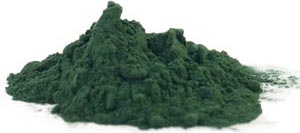I promise to keep this short. And will try to be not-boring.
The down and dirty version of why the superfood blue-green algae Aphanizomenon flos-aquae is good for you and your animals, in 25 words or less, is (and I promise not to use that Latin term again):

1. Blue-green algae is a raw, micro-nutrient-rich superfood.
2. Your body LOVES real food, as opposed to supplements, and utilizes it 10 times better.
There. That’s 25 words.
The part about “10

times better” is mine and mine alone, but is based on statistical and scientific evidence that the body absorbs, at most, only 12% of any man-made supplement, no matter how whole or natural its ingredients or how carefully it is made. Man-made supplements are not superfood. Period.
The reason? Your body simply does not recognize the latter because it is not programmed to. I’m not saying supplements are worthless. Quite the contrary — they’re very valuable and most of us, myself included, take them. But the bottom line is a Vitamin C tablet will never be a substitute for an orange. Period. Your body knows that and gets rid of all the “odd” substances in the tablet, utilizing only that which it recognizes — about 12% max. The orange on the other hand, or blue-green algae? “Yum!” says your body, “This is more like it!” and slurps it all up.
But let’s get a little more detailed.
Anything you eat, plant or animal, is only as nutritious as what IT ate. That

means that plants grown in depleted soil — even if “organic” — simply are not providing you with proper or complete nutritional value. Plain and simple, they cannot be a superfood even if they were meant to be. So one reason blue-green algae is such a powerful nutrient is that almost 100% of it is harvested from Upper Klamath Lake in Southern Oregon, where it thrives on nutrient-rich volcanic sediment that is 35 feet deep.
Another feature of blue-green algae that makes it so impacting is the fact that it is a single-cell food, with a non-cellulose cell wall, so is highly assimilable — this type of food is called a micronutrient. It has been proven, in fact, that our bodies are able to assimilate up to 98% of blue-green algae. Compare that to the 12% in man-made supplements and you begin to get the picture.
The Bottom Line:
Blue-green algae is an organic, all natural, single-cell, naturally occurring, micronutrient, whole superfood that contains:
- vitamins
- trace minerals
- amino acids
- active enzymes
- protein
- chlorophyll
- beta carotene
- essential fatty acids
- phytonutrients
A pretty complete nutritional profile, wouldn’t you say?
If you have an abundant, organic garden in your backyard, with super-enriched, alive soil, then you are a lucky dog and may be getting most of the nutrients you need from your food. You are growing superfood! But if not, consider adding a little of the micronutrient, blue-green algae, to your diet every day, and to your animals’ too. You can rest easy knowing it will fill in those nutritional gaps not provided by your grocery or pet food store.
So THAT’s the big deal about blue-green algae!
********************************************************************
You can read more about blue-green algae and order some HERE.
And read about my first personal experience with the algae here:
My Algae Story: How Blue-Green Algae Helped Heal My Allergies
And for feeding blue-green algae to your animals, check out these FAQs. Or email me and I’ll be happy to help you figure out a blue-green algae diet plan for your furry friends.
Recent Comments